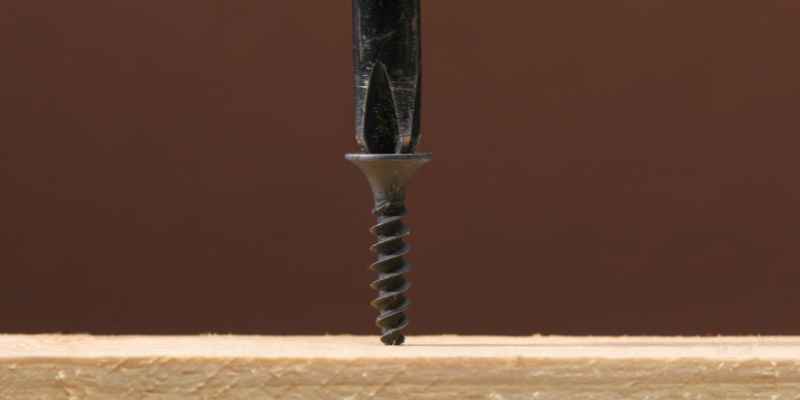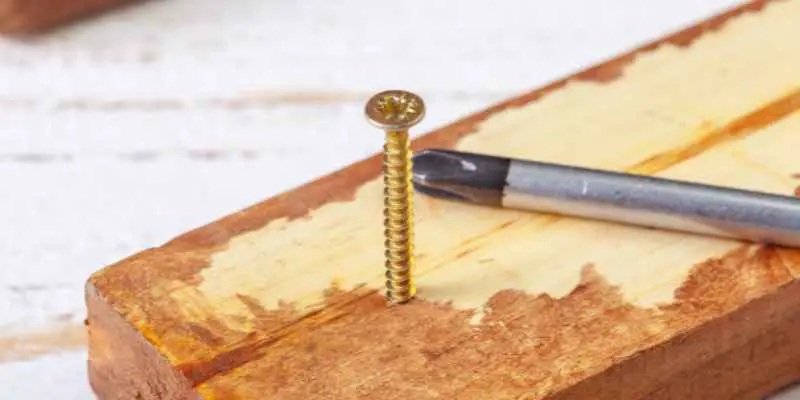Yes, you can screw into wood filler for screws. Wood filler provides a solid surface for screws to grip, allowing them to hold securely.
Wood filler is a versatile material commonly used in woodworking projects. It is a type of putty that can be used to repair and fill in holes, cracks, and gaps in wood surfaces. Once the wood filler is applied and dried, it becomes a hard, solid material that can be sanded, painted, and even drilled.
However, some people may wonder if it is possible to screw into wood filler. The answer is yes, you can screw into wood filler for screws. Wood filler provides a solid surface for screws to grip, allowing them to hold securely. This makes it a convenient solution for attaching objects or reinforcing joints in wood. Whether you are working on furniture repairs or building a DIY project, using wood filler in conjunction with screws can help you achieve a strong and durable result.
Understanding Wood Filler
Wood filler is a versatile product that is used to repair small imperfections, cracks, or holes in wooden surfaces. It is a putty-like substance that can be applied to fill gaps and create a smooth and even surface for painting, staining, or finishing. Wood filler is typically composed of a combination of wood fibers or sawdust and a binding agent, such as epoxy or latex, which helps the filler adhere to the wood.
How Is Wood Filler Used?
Wood filler is easy to use and can be applied to a variety of wooden surfaces. The process typically involves these steps:
- Clean the surface: Before applying wood filler, it’s essential to clean the area thoroughly to remove dirt, dust, or debris. This helps to ensure proper adhesion and a seamless finish.
- Prepare the wood filler: Wood fillers come in various formulations, including water-based, solvent-based, and epoxy-based. Follow the manufacturer’s instructions to prepare the filler accordingly.
- Apply the wood filler: Using a putty knife, spread the wood filler evenly over the damaged area. Fill the gap or hole completely, ensuring no air pockets are left behind.
- Smooth and shape the filler: While the filler is still wet, use the putty knife or a damp cloth to smooth and shape it to match the surrounding surface. Remove any excess filler and leave it to dry according to the product’s instructions.
- Sand and finish: Once the wood filler has dried and hardened, use sandpaper to smooth the repaired area. This creates a seamless surface that can be further enhanced with paint, stain, or varnish.
Wood fillers are available in different types, each suitable for specific applications. Here are some common types of wood filler:
| Type | Description |
|---|---|
| Water-based filler | Easy to use and clean up, water-based fillers are suitable for small repairs and finishing. |
| Solvent-based filler | These fillers offer fast drying times and are ideal for larger repairs or outdoor use as they are more durable. |
| Epoxy-based filler | Epoxy-based fillers are exceptionally strong and long-lasting, making them perfect for structural repairs or heavy-duty applications. |
| Wood putty | Wood putty is a softer and more pliable filler primarily used for filling nail holes or minor surface imperfections. |
Choosing the right type of wood filler depends on the nature and scale of the repair project. Understanding these different types can help you select the best filler for your needs.

Screwing Into Wood Filler
Wood filler is a popular solution for repairing and filling in gaps, cracks, or holes in wood surfaces. It is a versatile material that allows you to restore the integrity and aesthetics of wooden structures. But what about screwing into wood filler? Can it support screws effectively? Let’s explore this topic further.
Can You Screw Into Wood Filler?
It is possible to screw into wood filler, but it’s important to understand that wood filler is not as strong or durable as natural wood. While it can provide a temporary fix or hold screws for lightweight applications, it may not be suitable for heavy-duty projects.
Factors To Consider
Before screwing into wood filler, there are several factors you should consider:
- Depth and thickness: Ensure that the wood filler is applied to an adequate depth and thickness to provide sufficient support for the screws. The deeper and thicker the wood filler, the better it can hold the screws in place.
- Type of wood filler: Different types of wood filler have varying degrees of hardness and strength. Epoxy-based fillers tend to be more robust and offer better screw-holding capability compared to water-based or latex-based fillers.
- Curing time: Allow ample time for the wood filler to cure and harden before attempting to screw into it. Read the manufacturer’s instructions to determine the recommended curing time for the specific product you are using.
- Location: Consider where you plan to screw into the wood filler. If it’s in an area that will experience significant stress or weight-bearing, it’s advisable to reinforce the wood filler with additional support, such as using a dowel or installing a metal bracket.
Remember that wood filler is not a substitute for solid wood when it comes to screwing into it. If your project requires strong screw-holding capability, it’s recommended to use solid wood or find alternative solutions such as drilling into the wood and using anchors or brackets for added support.
By considering these factors, you can make an informed decision whether screwing into wood filler is suitable for your specific project. Always prioritize the long-term durability and stability of the wood structure to ensure the best results.

Boosting Your Craftsmanship
Wood filler is a versatile and practical DIY solution for filling in gaps, cracks, and holes in wooden surfaces. But did you know that it can also be used to enhance the stability and longevity of screws in your woodworking projects? By properly utilizing wood filler with screws, you can take your craftsmanship to the next level. In this article, we will explore some valuable tips for using wood filler with screws, discuss the benefits it brings to your projects, and highlight common mistakes to avoid. Let’s dive in!
Tips For Using Wood Filler With Screws
When it comes to using wood filler with screws, following a few key tips can greatly improve the overall strength and durability of your woodworking projects:
- Prepare the surface: Before applying wood filler, ensure that the surface is clean, dry, and free from any dust or debris. This will help the wood filler adhere better and create a strong bond with the wood.
- Select the right wood filler: Choose a high-quality wood filler that is compatible with the type of wood you are working with. Consider factors like drying time, color, and the ability to hold screws when making your selection.
- Apply the wood filler: Use a putty knife to evenly spread the wood filler over the areas where screws will be inserted. Make sure to fill the holes completely, leaving no empty spaces.
- Drive screws into the wood filler: Once the wood filler has dried, you can then drive screws into the material. Use steady pressure and avoid over-tightening to prevent the filler from cracking or splitting.
- Allow for drying time: Give the wood filler enough time to fully dry and cure before sanding or painting the surface. This will ensure a smooth and seamless finish.
Benefits Of Using Wood Filler With Screws
Utilizing wood filler with screws offers a range of benefits that can significantly enhance your woodworking projects:
- Improved stability: When screws are inserted into wood filler, they become anchored in a solid and secure material, reducing the risk of loosening or wobbling over time.
- Enhanced aesthetics: Wood filler allows you to create a seamless and polished look by filling in unsightly gaps and holes around the screws.
- Increased durability: By reinforcing screw holes with wood filler, you can strengthen the overall structure of your wooden surfaces, making them more resistant to wear and tear.
- Expanded material options: Wood filler can be used with various types of wood, making it a versatile solution for projects involving different wood species.
Common Mistakes To Avoid
To ensure optimal results when using wood filler with screws, be mindful of these common mistakes:
- Overfilling: Applying excessive amounts of wood filler can lead to cracking or bulging, compromising the integrity of your project. Follow the manufacturer’s instructions for the recommended application thickness.
- Underfilling: On the other hand, insufficient wood filler may not provide enough support for the screws, resulting in instability and potential damage.
- Skipping surface preparation: Neglecting to clean and prepare the surface before applying wood filler can hinder its adhesion, leading to weak joints.
- Rushing the drying process: Patience is key when working with wood filler. Allowing sufficient drying time is crucial to achieve a strong bond and optimal finish.
By following these tips and avoiding common mistakes, you can harness the power of wood filler to enhance the strength, aesthetics, and durability of your woodworking projects. Now that you have a better understanding of how to use wood filler with screws, it’s time to put your newfound knowledge into practice and take your craftsmanship to new heights!
Conclusion
Wood filler can be a useful solution for repairing damaged wood surfaces. While it may seem tempting to screw directly into the wood filler, it is not a reliable option. Wood filler lacks the strength and stability needed to securely hold screws in place.
To ensure a strong and long-lasting connection, it is best to drill into solid wood. So, keep this in mind when undertaking any project involving screws and wood filler.


